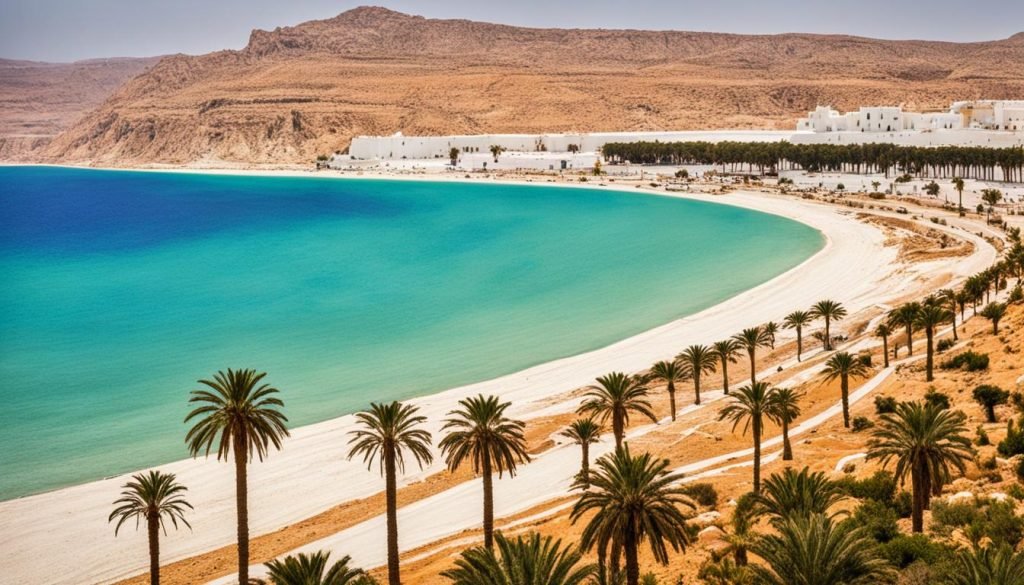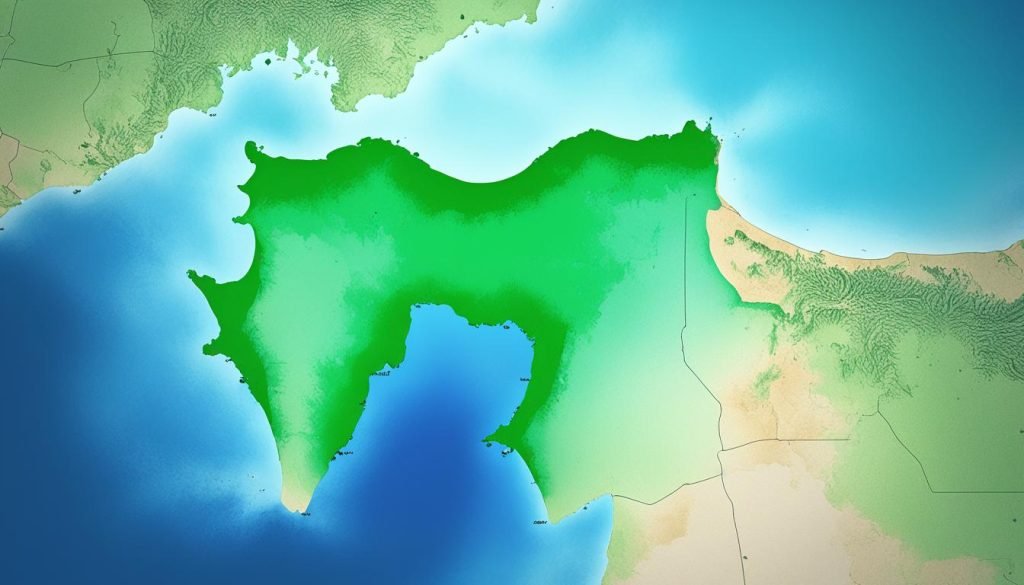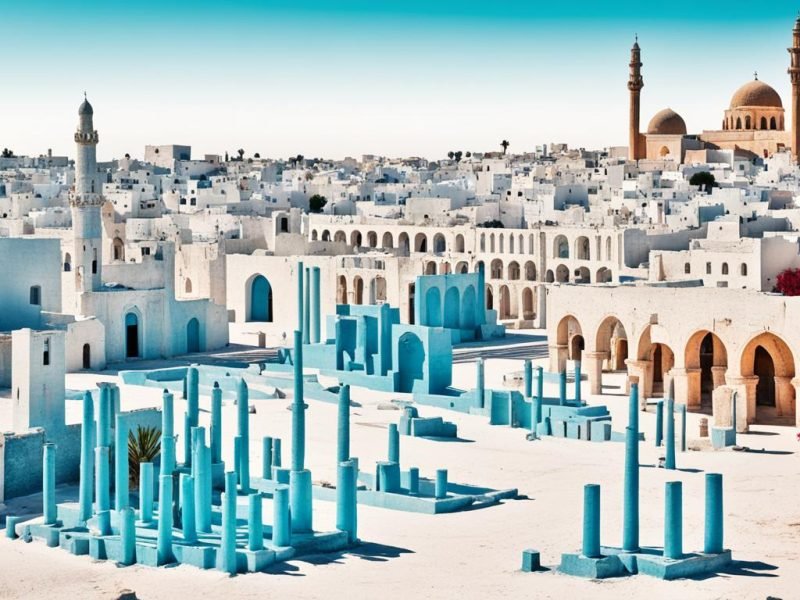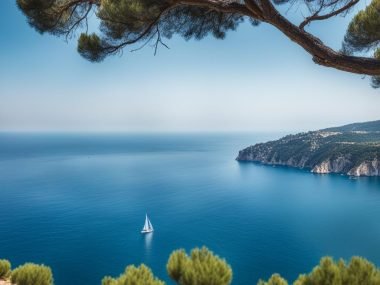Planning a trip to Tunisia might have you wondering about its cooler weather. It’s smart to be curious about Tunisia weather December January February and Tunisia winter temperature. In Tunisia’s north, expect mild, rainy winters and hot, dry summers. But, the Sahara desert in the south changes everything, giving Tunisia very different weather. The weather changes a lot from the cold Kroumirie mountains to hot desert days in the summer.
If you’re asking, “Does Tunisia Get Cold?,” know this. Tunisia gets over 3,000 hours of sunshine a year, especially in its deserts. Yet, the temperature can drop, especially in high places or inside the country during winter. Also, climate change has made temperatures go up by about 1.2°C since the early 20th century, changing the usual weather.
Key Takeaways
- Understanding Tunisia seasonal climate variations is key to planning your visit.
- The north’s Mediterranean climate differs significantly from the south’s desert conditions.
- Tunisia weather December January February can see temperatures drop sharply, particularly in mountainous areas.
- Climate patterns in Tunisia have changed, with temperatures on the rise.
- Despite a sunny disposition, Tunisia’s winter can demand warm clothing for chilly nights.
- Asking “Does Tunisia Get Cold?” reveals a fascinating climate diversity, from Mediterranean coasts to Saharan dunes.
- Exploring Tunisia during winter offers a unique blend of mild coastal climates and potential sub-zero mountainous regions.
Understanding Tunisia’s Diverse Climate Zones
Tunisia’s climate stretches from lush Mediterranean coasts to the vast Sahara Desert. It shows a strong contrast. This range is key to understanding the scenic changes. It also helps prepare for your visit, with its impact on weather patterns. These patterns show stark regional contrasts and varied seasonal climates.
Geographical Influence on Weather Patterns
In the north, Tunisia has a temperate climate due to mountains and the sea. Moving southwards, the climate becomes hot and dry. Eventually, it turns into the harsh Sahara. Geography plays a big role in these changes.
Contrast Between Northern Mountains and Southern Desert
The Northern mountains are lush and cool because they get good rainfall. This happens especially during Tunisia’s coldest months. Meanwhile, the Southern desert is extremely dry. It sees big temperature changes. This contrast affects Tunisia’s nature and culture.
Seasonal Climate Variations Across the Country
Throughout the year, Tunisia faces different weather. Winters can get very cold, like the chilly February in Thala. Summers can get very hot. Places like El Borma in the South heat up a lot.
Climate change is changing Tunisia’s weather. It’s making average temperatures shift. These changes could harm water, farming, and the economy. Knowing about these changes is important for locals and tourists.
| Season | Region | Avg Low Temp (°C) | Avg High Temp (°C) |
|---|---|---|---|
| Winter | North Mountains | -2 | 12 |
| Summer | South (El Borma) | 33 | 54 |
| Winter | South (Sahara) | 10 | 25 |
| Summer | North Coastal | 20 | 35 |

The Chilling Truth: Winter Temperatures in Tunisia
Planning a winter trip to Tunisia? It’s key to know about the weather changes. The climate varies across the region. Knowing the temperatures from December to February will make your trip better.
Tunisia Winter Temperature: A Closer Look
The winter temperature in Tunisia changes a lot based on where you are. In the north, it can get below freezing in the coldest months. Coastal areas have warmer weather. In the north, winter temperatures range from 12 to 28.7 degrees Celsius. There’s moderate rainfall, so bring light and warm clothes.
Navigating Tunisia’s Coldest Months: From December to February
December to February are Tunisia’s coldest months. The weather gets cooler, especially in the north mountains. These months are great if you want to avoid the hot Tunisian summers. Just make sure you pack right. You’ll need clothes for cool days and possibly icy nights.
Want to be ready for winter in Tunisia? Here are some tips:
- Layering is key: Bring various clothes that you can wear over each other. This helps you adjust to changing temperatures.
- Protective outerwear: A good jacket or coat is a must for the cold, especially at night in the interior regions.
- Footwear: Pick comfortable, insulated shoes for exploring or going into the mountains.
Knowing the weather in Tunisia from December to February is essential. Whether you’re in the snowy Atlas mountains or enjoying a mild night by the Mediterranean, being prepared lets you enjoy Tunisia’s winter beauty and variety to the fullest.
“Does Tunisia Get Cold?” Exploring Regional Temperature Averages
Planning your trip means knowing the Tunisia regional climate and Tunisia temperature averages by month. This is key if you’re planning to visit in Tunisia weather December January February. We’ll look at the temperature patterns in various parts of Tunisia. This will help you know what to pack and what to expect.
| Region | Winter Average Temperature (°C) | Summer Average Temperature (°C) |
|---|---|---|
| Tunis | 12.3 | 28.7 |
| Sousse | 14.5 | 32.0 |
| Djerba | 15.2 | 33.0 |
| Thala | 6.5 | 25.5 |
| Tozeur | 10.0 | 39.0 |
The data shows how the regional climate affects temperature averages in Tunisia. Coastal places like Tunis, Sousse, and Djerba have gentler winters and warm summers. They are perfect for winter holidays. Meanwhile, inland areas like Thala see bigger temperature changes. This is important for those wanting to see Tunisia’s varied terrains in the cooler months.

Tunisia’s Seasonal Wardrobe: What to Wear During the Colder Months
Planning your winter trip to Tunisia? Knowing what to wear can make it better. Tunisia is usually warm, but winters can get cool. This is true in mountain areas and during desert nights. We’ll talk about what clothes are best to make sure you enjoy your journey. This will include Tunisia winter clothing recommendations and Tunisia winter travel tips.
Tunisia Winter Clothing Recommendations
Along the coast, like in Tunis, you won’t need heavy winter clothes. Light jackets or sweaters are enough. But in the mountains, it gets much colder. Make sure to pack a down jacket, thermal tops, and warm pants. The desert gets cold at night, even if days are warm. Bring a sturdy jacket, warm sweater, and a scarf for the cold and sandstorms.
Packing Essentials for Tunisia’s Winter Season
When you pack for Tunisia in winter, be ready for changing weather. Here’s a packing list to help you:
- Layered clothing: Adjustable layers are best from warm days to cold nights.
- Durable walking shoes: Great for city walks and rural trails.
- Accessories: Hats, gloves, and scarves are must-haves after sunset.
- Lightweight backpack: Pick a light bag for daily use.
- Cultural consideration clothing: Wear modest outfits that cover shoulders and knees, especially in less touristy areas.
By following these tips and clothing ideas for Tunisia’s winter, you’ll be comfortable and respectful of local customs. Whether you’re exploring historic Tunisian cities or hiking mountain trails, the right clothes can improve your trip. Stay warm and fit in with the culture.
Weathering the Cold in Tunisia: Activities and Attractions
Your wanderlust might take you to Tunisia as winter comes. This country, with its rich culture and varied lands, shines even in the cooler weather. You can explore all its seasonal beauty without the summer’s scorching heat.
Discovering Tunisia’s Winter Activities
Tunisia is known for hot summers, but winter shows its beauty too. You could see the Kroumirie Mountains covered in snow or the peaceful Sahara desert. There’s a chance to see Carthage’s ancient ruins and the old medina of Tunis. The cool air adds to the magic of these places.
If you’re looking for action, try hiking in the mountains. Or, discover local traditions at the olive harvest festivals. These winter activities make for a lively experience.
Planning Your Winter Travel: Must-See Attractions
Visiting Tunisia in winter lets you avoid the crowds. The Mediterranean climate is perfect for seeing farms on the Cap Bon peninsula. You can see how olives and grapes are grown there. For an unforgettable sight, don’t miss Chott el Djerid, a vast salt lake with stunning mirages in winter.
As you explore, remember the effects of climate change on these wonders. Your mindful travel helps protect Tunisia’s beauty for the future.







